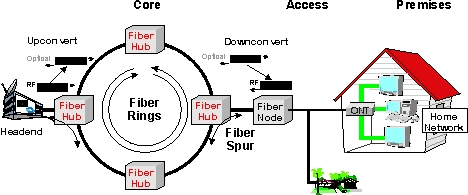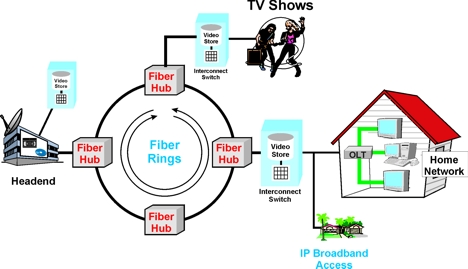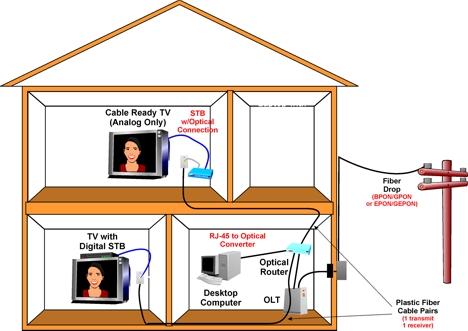|
 |
|
An optical distribution network is a system of optical transmission lines and signal routing equipment that links media sources to television viewing devices. An IPTV optical distribution system may contain several types of distribution systems, including a core network, access network, and premises distribution network.
The core network is the central network portion of a communication system. The core network primarily provides interconnection and transfer between content sources (such as the television head end) and the edge access networks. The core network may simultaneously transport hundreds of television channels that can be viewed by multiple subscribers.
Access network is a portion of a communication network (such as the public switched telephone network) that allows individual subscribers or devices to connect to the core network. IPTV optical access networks may provide a mix of analog channels (television channels) and digital channels (digital audio or video).
A premises distribution network is the equipment and software that is used to transfer data and other media in a customer's facility or home. A PDN is used to connect terminals (computers) and media devices (such as TV set top boxes) to each other and to wide area net |
work connections. PDN systems may use wired Ethernet, wireless LAN, powerline, coaxial, phone lines, or optical fiber to transfer data or media. Optical fiber premises distribution is a relatively new option for media distribution in the home.
Figure 1 shows that an optical distribution network can be composed of 3 key optical parts; a core network, an access network, and a premises distribution network. The core network converts several hundred television channels to optical signals and distributes them around loop to fiber hubs that are linked to fiber nodes. The fiber nodes are the access portion of the network which can receive, convert, and route television and data signals to the home. The home receives the media signals and converts them into an optical format that can route the signals to devices in the home.
Fiber Ring Core Network
The core network is the central network portion of a communication system. The core network primarily provides interconnection and transfer between edge networks. Core networks in IPTV systems can
be setup as fiber rings and spurs. A fiber ring is an optical network
of topology with a connection that provides a complete loop. The ring topology is used to provide a backup distribution path as |
|
|
|
 |
|
Figure 1., IPTV Optical Distribution |
|
traffic needs to be quickly rerouted in the other direction around the loop in the event of a fiber cut. A fiber spur is a fiber line that extends the fiber ring into another area for final distribution.
The core network may use multiple wavelengths per fiber to increase the capacity of each fiber line. The core network may simultaneously transfer (simulcast) programming (television) channels in analog or digital form. When viewers want to watch one of these channels (such as a television network channel), their set-top box is simply connected to one of these shared channel sources through an access node.
When viewers want to watch an on-demand program (such as a movie), they require a connection to a media source. Media sources |
may be located nearby the user or at other locations within or outside the core network.
Figure 2 shows how on-demand programming may be provided from media servers that are located near the viewer, at another location within the core network, or from other networks that are interconnected to the core network.
Optical Access Network
Optical access networks link the customer to the IPTV system via a fiber or free space optical connection. These optical connections may be a mix of unique (proprietary) formats or industry standard formats (such as BPON, GPON, or
EPON). |
|
 |
|
Figure 2., IPTV On-Demand Distribution |
|
There are two key types of industry standard optical access networks that are used IPTV systems; asynchronous transfer mode (ATM) based and Ethernet based. ATM is a connection oriented packet data switching technique that transfers information by using fixed length 53 byte cells through a pre-defined connection path. Ethernet is a packet based transmission protocol that can dynamically change its packet length and routing paths. Broadband passive optical network (BPON) and gigabit passive optical network (GPON) are ATM based and Ethernet passive optical network (EPON) and gigabit Ethernet passive optical network (GEPON) are Ethernet based. ATM based systems offer higher levels of quality control and have been in use for longer periods of time but Ethernet based systems are simpler to deploy and can have much lower equipment costs.
BPON systems are evolving to higher-speed GPON systems. The maximum number of customers per BPON node is 32 compared to the maximum number of customers of a GPON node, which is 128 [i].
EPON systems are evolving to higher speed GEPON systems. While there is no defined limit on the number of devices that can be connected to an EPON node, each device that is added to the EPON node splits (reduces) the signal level which limits the maximum number of EPON devices per node to approximately 64 [ii]. |
Premises Distribution Network (PDN)
Optical premises distribution networks use optical cable to transfer data and other media within a customer's facility or home. Because the distances connected in home or business networks are relatively short, optical PDN systems can use low cost plastic fiber instead of high-cost glass fibers.
Plastic optical fiber (POF) is constructed of a plastic core that is coated with a plastic cladding. POFs have a wide core (approximately 1000 um) and they are more resistant to breakage. POF is low cost, light, thin, and relatively easy to install. Optical cable for home networks is a very small cable that is approximately the size of cable that is used for MP3 headset earplugs.
Optical premises distribution systems use a pair of low power optical transmission fibers in each cable, one for transmit and one for receiving. Home optical systems use one red light source that can be directly viewed by an installer while the other that is not visible [iii]. This allows the installer to know if the fiber is connected and which side of the plug to insert the fiber into (the one without the red light - the receiver).
The speed of the PON system is currently 100 Mbps and 1 Gbps home optical networks are anticipated in the future. The maximum distance for a home optical line is approximately 40 to 100 meters. For |
|
 |
|
Figure 3., Plastic Optical Fiber Home Distribution System |
|
extended distances, repeaters can be installed to detect, recreate, and retransmit the optical signals.
Figure 3 shows how a home optical system can be setup and used in a home. This diagram shows that an optical access connection is connected to a residential gateway. The gateway acts as a bridge to convert the BPON/GPON or EPON/GEPON signal into a POF format that can be distributed in the home over plastic optical fiber. Each optical cable contains two fiber pairs, one for transmitting and one for receiving.
Low cost plastic optical distribution systems are not new. In the mid-1990s a media oriented systems transport (MOST) was developed |
for use in cars [iv]. By the late 2000s, millions of POF systems have been installed in cars.
i . "EPON vs. GPON: A Practical Comparison," Onn Haran, Passave Technologies, CommsDesign, Jan 25, 2005, pg. 3.
ii . Ibid, pg. 3.
iii . "Simply POF High-End Connectivity with 1394/Ethernet Over Plastic Fiber"
http://www.1394ta.org/Technology/SIMPLY_POF.pdf
iv . "Ethernet Over Plastic Optical Fibre," Mike Jones, Senior FAE, Micrel Inc., http://www.future-mag.com/0706/0706130.asp. |
|
|
|